
Here you can study for the exam. Look up keywords and learn definitions about all kind of subjects.
More subjects
The bacon and egg pie is a savoury pie consisting of a crust containing bacon, egg and sometimes onion, mushrooms, bell peppers, peas, tomato, fresh herbs and cheese. It is popular in New Zealand. However, bacon and egg pie originated during the middle ages in Cornwall and is still a popular pie cooked in Cornish homes today (although rarely found in Cornish bakeries). For many Cornish people, a bacon and egg pie is more of a taste of home than the famous Cornish pasty. Bacon and egg pie may be served with ketchup, which can be combined with Worcestershire sauce and drizzled over the filling before the pie is baked and some versions have a rising agent such as baking powder mixed into the egg to make a fluffier filling. (Source: Wikipedia.org, CC BY-SA)
A meat pie is a pie with a filling of meat and often with other savory ingredients. They are found in cuisines worldwide. Meat pies are usually baked, fried, or deep fried to brown them and develop the flavour through the Maillard reaction. Many varieties have a flaky crust. (Source: Wikipedia.org, CC BY-SA)
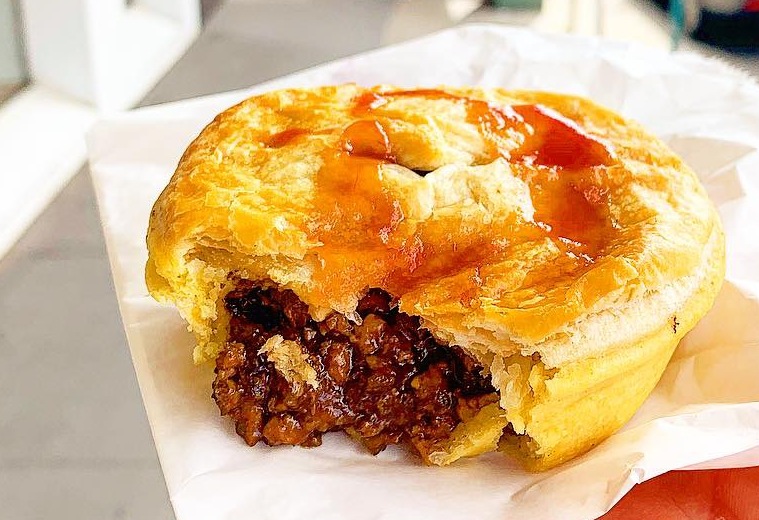 © Wikimedia.org/Finbar.concaig, CC BY-SA
© Wikimedia.org/Finbar.concaig, CC BY-SA
Pavlova is a meringue-based dessert. Originating in either Australia or New Zealand in the early 20th century, it was named after the Russian ballerina Anna Pavlova. Taking the form of a cake-like circular block of baked meringue, pavlova has a crisp crust and soft, light inside. The confection is usually topped with fruit and whipped cream. The name is commonly pronounced /pævˈloʊvə/ pav-LOH-və or (in North America) /pɑːvˈloʊvə/ pahv-LOH-və, and occasionally closer to the name of the dancer, as /ˈpɑːvləvə/ PAHV-lə-və. The dessert is believed to have been created in honour of the dancer either during or after one of her tours to Australia and New Zealand in the 1920s. The nationality of its creator has been a source of argument between the two nations for many years. (Source: Wikipedia.org, CC BY-SA)
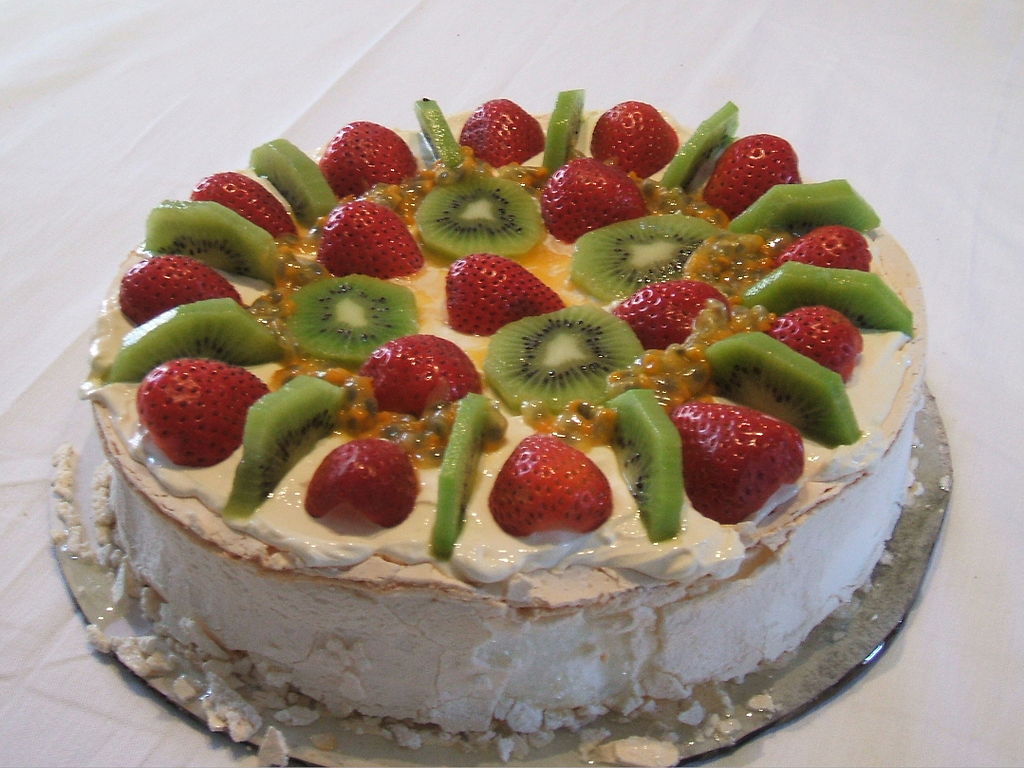 © Wikimedia.org/Hazel Fowler, CC0
© Wikimedia.org/Hazel Fowler, CC0
Gallo pinto or gallopinto is a traditional dish from Central America. Consisting of rice and beans as a base, gallo pinto has a long history and is important to Nicaraguan identity and culture, just as rice and beans variations are equally important in many Latin American cultures as well. The beans in gallo pinto are quickly cooked until the juice is almost consumed, then combined with prepared rice and other ingredients such as cooked bell peppers, coriander, chopped onions, and garlic. In Nicaragua, gallo pinto is made mainly with red beans. In addition, vegetable oil is used for cooking (includes onions). The gallo pinto can be eaten in Nicaragua at any time and is the main companion of the different dishes sold in a fritanga (food stall). (Source: Wikipedia.org, CC BY-SA)
A nacatamal is a traditional dish found in Nicaragua similar to the tamal and to the hallaca. Its name originates from the Nawat language spoken by the Nicarao, which were situated on the Southern Pacific coast of Nicaragua, and translates to 'meat tamale'. The nacatamal is perhaps the most produced within traditional Nicaraguan cuisine and is typically eaten on the weekend, for dinner, or for breakfast; it is usually eaten together with white bread and a caffeinated drink like black coffee, Coca-Cola or Pepsi. It is common to enjoy nacatamales (plural) during special occasions and to invite extended family and neighbors to partake. (Source: Wikipedia.org, CC BY-SA)
 © Wikimedia.org/Joroman2k, CC BY-SA
© Wikimedia.org/Joroman2k, CC BY-SA
Vigorón is a traditional Nicaraguan dish. It consists of a cabbage salad (chopped cabbage, tomatoes, onions, and chili pepper marinated in vinegar and salt), boiled yuca, and chicharrones (fried pork belly or fried pork rinds), all wrapped in a banana leaf. This dish is often eaten without utensils, and it is frequently served to visiting family and guests, as it is generally easily and quickly prepared. (Source: Wikipedia.org, CC BY-SA)
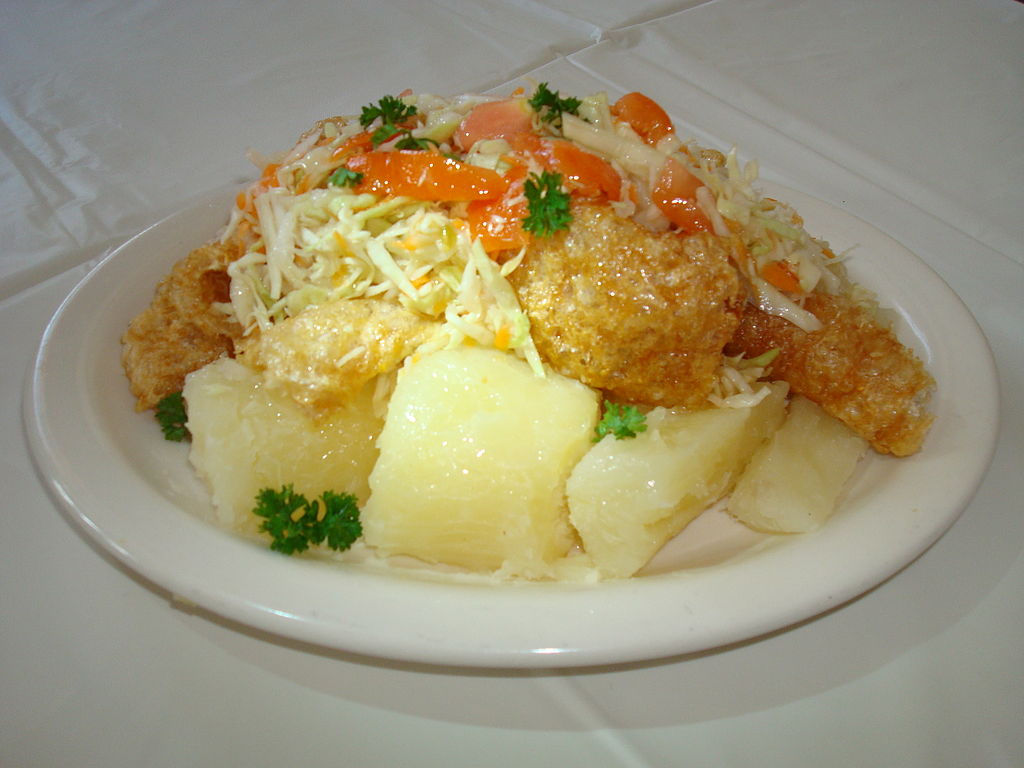 © Wikimedia.org/Nicaraguan food, CC0
© Wikimedia.org/Nicaraguan food, CC0
Dambou (also Dambu) is a dish native to the Zarma and Songhai of Southwestern Niger made from cereals and Moringa. It is consumed at any time but mainly during festive occasions such as outdoorings and weddings. This dish is also common among the Dendi people of North Benin and other West African cities. It is also common in the Zongo Settlements where the Songhai and Zarma travel. Dambou is prepared according to the desire and will of the cook. For a simple dish, cooks mostly use either: rice flour or fine hard wheat semolina (couscous semolina) or millet, wheat or corn couscous. The cereals is steamed for about 20 to 30 minutes and added the already boiled moringa leaves. Finally, the other ingredients are added in their raw state: i.e onion, chili, salt, broth, peanut, vegetable oil, meat or fish as a side dish. (Source: Wikipedia.org, CC BY-SA)
Jollof (/dʒəˈlɒf/), or jollof rice, is a rice dish from West Africa. The dish is typically made with long-grain rice, tomatoes, onions, spices, vegetables and meat in a single pot, although its ingredients and preparation methods vary across different regions. Although considerable variation exists, the basic profile for Nigerian jollof rice includes long-grain parboiled rice, tomatoes and tomato paste, pepper, vegetable oil, onions, and stock cubes. Most of the ingredients are cooked in one pot, of which a rich meat stock and a fried tomato and pepper puree characteristically forms the base. Rice is then added and left to cook in the liquid. The dish is then served with the protein of choice and very often with fried plantains, moi moi, steamed vegetables, coleslaw, salad, etc. In the riverine areas of Nigeria where seafood is the main source of protein, seafood often takes the place of chicken or meat as the protein of choice.[citation needed] (Source: Wikipedia.org, CC BY-SA)
Tuwon shinkafa is a type of Nigerian and Nigerien rice swallow from Niger and the northern part of Nigeria. It is a thick pudding prepared from a local rice that is soft and sticky, and is usually served with different types of soups like miyar kuka, miyar kubewa, and miyar taushe. Two variants made from maize and sorghum flour are called tuwon masara and tuwon dawa, respectively. In Ghana, tuwon shinkafa is called omo tuo. (Source: Wikipedia.org, CC BY-SA)
Tavče gravče (Macedonian: Тавче-гравче) is a traditional Macedonian dish. It is prepared with fresh beans and can be found in many restaurants in North Macedonia. It is also commonly eaten by the Macedonian diaspora. This meal is baked and served in a traditional unglazed earthenware pot. The name of the dish may be translated as 'beans on a tava'. Tavče gravče is considered the national dish of North Macedonia. 'Tavče gravče Tetovo style' is a popular regional variation.[citation needed] (Source: Wikipedia.org, CC BY-SA)
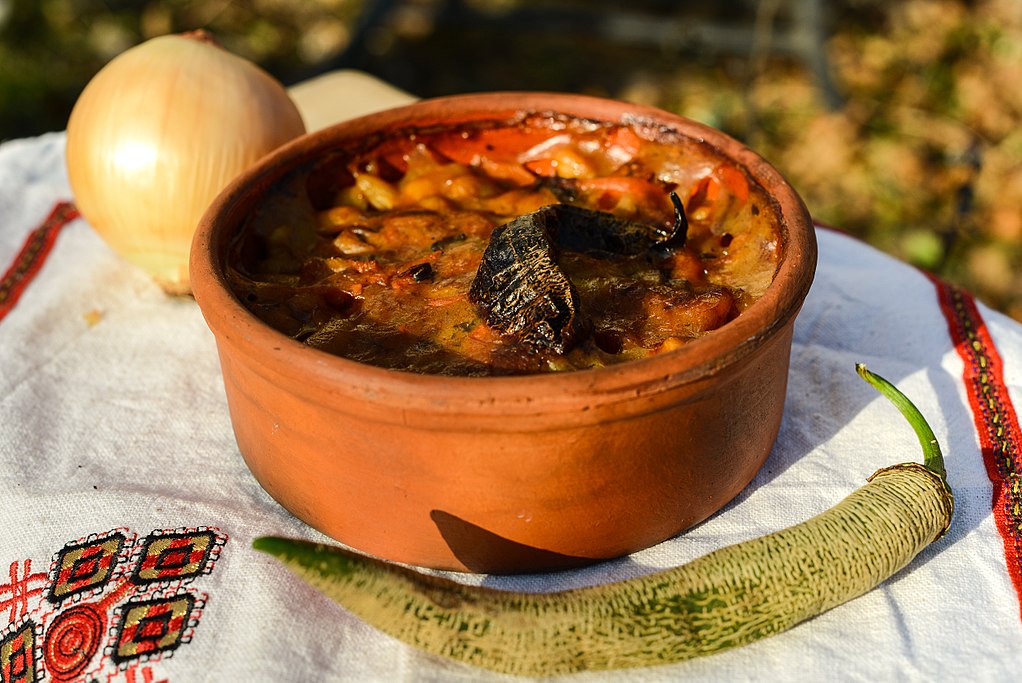 © Wikimedia.org/Oliver Manev, CC BY-SA
© Wikimedia.org/Oliver Manev, CC BY-SA
Kimchi (/ˈkɪmtʃiː/; Korean: 김치, romanized: gimchi, IPA: [kim.tɕʰi]), is a traditional Korean banchan consisting of salted and fermented vegetables, most commonly using napa cabbage or Korean radish. A wide selection of seasonings are used, including gochugaru (Korean chili powder), spring onions, garlic, ginger, and jeotgal (salted seafood), etc. Kimchi is also used in a variety of soups and stews. Kimchi is a staple food in Korean cuisine and is eaten as a side dish with almost every Korean meal. There are hundreds of different types of kimchi made with different vegetables as the main ingredients. Traditionally, winter kimchi, called kimjang, was stored in large earthenware fermentation vessels, called onggi, in the ground to prevent freezing during the winter months and to keep it cool enough to slow down the fermentation process during summer months. The vessels are also kept outdoors in special terraces called jangdokdae. In contemporary times, household kimchi refrigerators are more commonly used. (Source: Wikipedia.org, CC BY-SA)
Naengmyeon (냉면; 冷麵, in South Korea) or raengmyŏn (랭면, in North Korea) is a noodle dish of North Korean origin which consists of long and thin handmade noodles made from the flour and starch of various ingredients, including buckwheat (메밀, memil), potatoes, sweet potatoes, arrowroot starch (darker color and chewier than buckwheat noodles), and kudzu (칡, chik). Buckwheat predominates (despite the name, it is not a wheat but rather is more closely related to sorrel). Other varieties of naengmyeon are made from ingredients such as seaweed and green tea. In modern times, the mul naengmyeon (물 냉면) variant is commonly associated with and popularly consumed during the summer; however, it was historically a dish enjoyed during winter. (Source: Wikipedia.org, CC BY-SA)
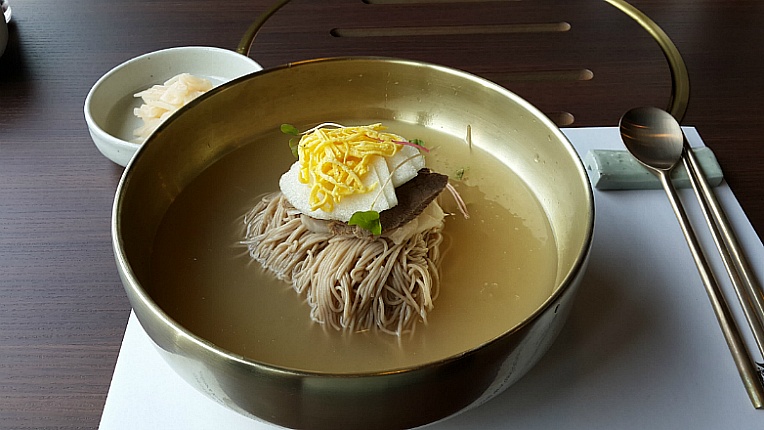 © Wikimedia.org/wjlee4284, CC BY
© Wikimedia.org/wjlee4284, CC BY
Fårikål (Norwegian pronunciation: [ˈfòːrɪkɔɫ, ˈfɔ̀rːɪkɔɫ]) is a traditional Norwegian dish, and the country's national dish. It consists of pieces of mutton with bone, cabbage, whole black pepper and occasionally a little wheat flour, cooked for several hours in a casserole, traditionally served with potatoes boiled in their skins. The dish is typically prepared in early autumn, and over 70 % of the Norwegian population reports eating the dish at least once during this time period. Fårikål Feast Day is celebrated on the last Thursday in September each year. (Source: Wikipedia.org, CC BY-SA)
Biryani (/bɜːrˈjɑːni/) is a mixed rice dish originating in South Asia. It is made with Indian spices, vegetables, rice, and usually some type of meat (chicken, beef, goat, lamb, prawn, and fish), or in some cases without any meat, using Paneer or simply vegetables. Occasionally, eggs and potatoes are also included. Biryani is one of the most popular dishes in South Asia, as well as among the diaspora from the region. Similar dishes are also prepared in other parts of the world such as in Iraq, Myanmar, Thailand, and Malaysia. Biryani is the single most-ordered dish on Indian online food ordering and delivery services, and has been labelled as the most popular dish overall in India. (Source: Wikipedia.org, CC BY-SA)
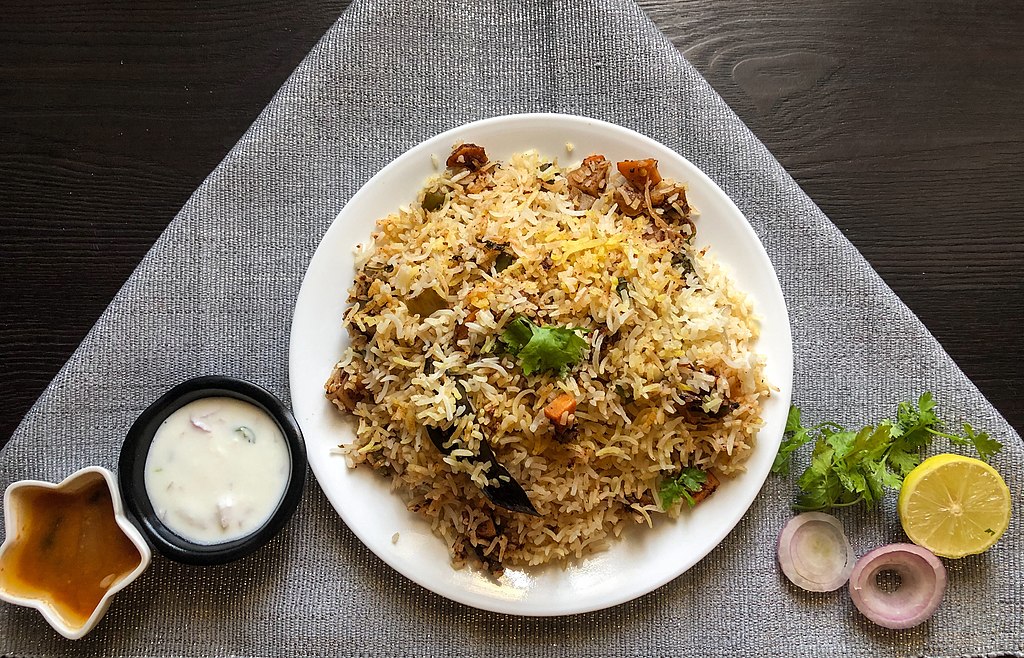 © Wikimedia.org/Mahi Tatavarty, CC BY-SA
© Wikimedia.org/Mahi Tatavarty, CC BY-SA
Gulab jamun (also spelled gulaab jamun; lit. 'Rose water berry' or 'Rose berry') is a sweet confectionery or dessert, originating in the Indian subcontinent and a type of mithai popular in India, Pakistan, Nepal, the Maldives (where it is known as gulab ki janu), and Bangladesh, as well as Myanmar. It is also common in nations with substantial populations of people with South Asian heritage, such as Mauritius, Fiji, Gulf states, the Malay Peninsula, Great Britain, South Africa, and the Caribbean countries of Trinidad and Tobago, Guyana, Suriname, and Jamaica. It is made mainly from milk solids, traditionally from khoya, which is milk reduced to the consistency of a soft dough. Modern recipes call for dried or powdered milk instead of khoya. It is often garnished with dried nuts such as almonds and cashews to enhance flavour. (Source: Wikipedia.org, CC BY-SA)
Nihari (Hindi: निहारी; Bengali: নিহারী; Urdu: نہاری) is a stew originating in Lucknow, the capital of 18th-century Awadh under the Mughal Empire in the Indian subcontinent. It consists of slow-cooked meat, mainly a shank cut of beef, lamb and mutton, or goat meat, as well as chicken and bone marrow. It is flavoured with long pepper (pippali), a relative of black pepper. In Pakistan and Bangladesh, nihari is often served and consumed with naan. (Source: Wikipedia.org, CC BY-SA)
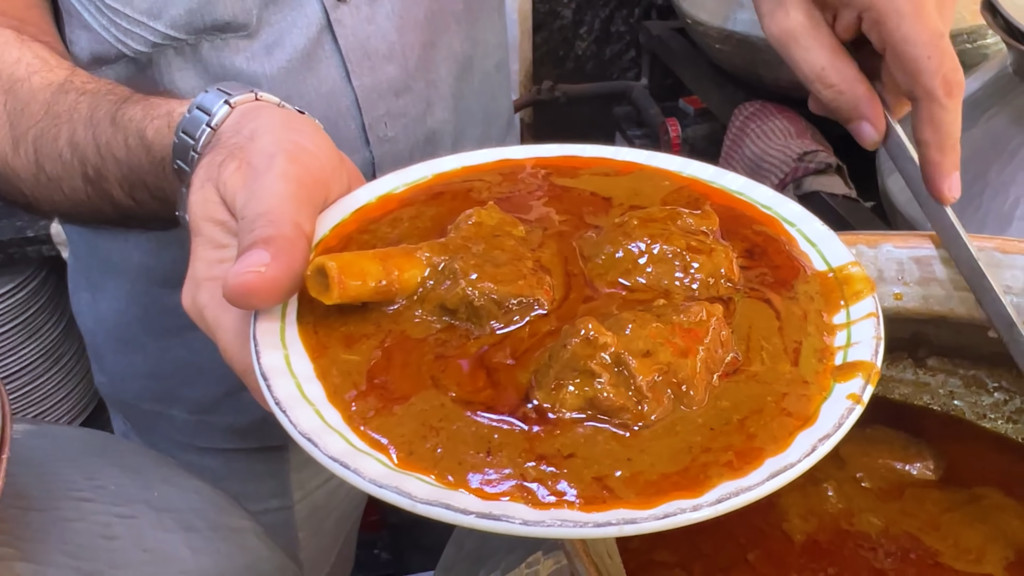 © Wikimedia.org/Kxnyshk, CC BY-SA
© Wikimedia.org/Kxnyshk, CC BY-SA
Maqluba or Maqlooba (Arabic: مقلوبة) is a traditional Iraqi, Lebanese, Palestinian, Jordanian, and Syrian dish served throughout the Levant. It consists of meat, rice, and fried vegetables placed in a pot which is flipped upside down when served, hence the name maqluba, which translates literally as 'upside-down.' The dish goes back centuries and is found in the Kitab al-Tabikh, a collection of 13th century recipes. Maqluba can include a variety of vegetables, such as fried tomatoes, potatoes, cauliflower, and eggplant, accompanied by either chicken or lamb. The most common are cauliflower and eggplant. All the ingredients are carefully placed in the pot in layers, so that when the pot is inverted for serving, the dish looks like a layer cake. Maqluba is typically garnished with pine nuts and chopped fresh parsley. It sometimes served with salad and fresh yogurt, and is often prepared for feasts and large gatherings. (Source: Wikipedia.org, CC BY-SA)
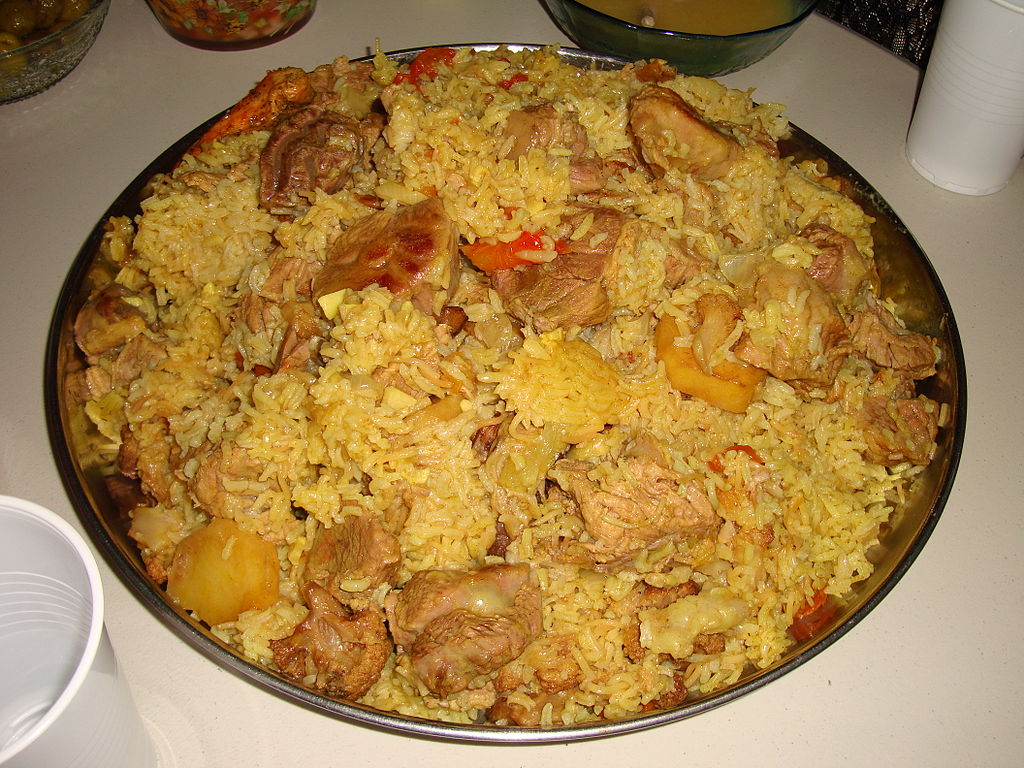 © Wikimedia.org/Arafataslan, CC0
© Wikimedia.org/Arafataslan, CC0
Musakhan (Arabic: مسخّن, lit. 'something that is heated'), also known as muhammar (Arabic: محمر, lit. 'reddish'), is a Palestinian dish composed of roasted chicken baked with onions, sumac, allspice, saffron, and fried pine nuts served over taboon bread. Originating in the Tulkarm and Jenin area, musakhan is often considered the national dish of Palestine. The dish is particularly popular among Palestinians, Israeli Arabs and Jordanians. In Israel, it is eaten by Israeli Arabs and Israeli Druze in Galilee, especially around Iksal and Sandala, and in the Triangle. The dish can be found in Syria, Lebanon and Jordan as well. Musakhan is simple to make and the ingredients needed are easily obtainable, which may account for the dish's popularity. Many of the ingredients used—olive oil, sumac and pine nuts—are staples of Palestinian cuisine. The dish is typically eaten with one's hands. It is usually presented with the chicken on top of the bread, and could be served with soup. (Source: Wikipedia.org, CC BY-SA)
 © Wikimedia.org/Kokaly, CC BY-SA
© Wikimedia.org/Kokaly, CC BY-SA
Sancocho (from the Spanish verb sancochar, 'to parboil') is a traditional soup in several Latin American cuisines. Variations represent popular national dishes in Dominican Republic, Colombia, Cuba, Honduras, Ecuador, Panama, Puerto Rico, Trinidad and Tobago, and Venezuela. It usually consists of large pieces of meat, tubers and vegetables served in a broth. (Source: Wikipedia.org, CC BY-SA)
 © Wikimedia.org/Daguerreroa, CC BY-SA
© Wikimedia.org/Daguerreroa, CC BY-SA
Ceviche (Spanish pronunciation: [seˈβitʃe]) is a Hispanic America dish typically made from fresh raw fish cured in fresh citrus juices, most commonly lime or lemon. It is also spiced with ají, chili peppers or other seasonings, and julienned red onions, salt, and cilantro are also added. Because the dish is eaten raw and not cooked with heat, it must be prepared fresh and consumed immediately to minimize the risk of food poisoning. Ceviche is often eaten as an appetizer; if eaten as a main dish, it is usually accompanied by side dishes that complement its flavors, such as sweet potato, lettuce, maize, avocado, or cooking banana. (Source: Wikipedia.org, CC BY-SA)
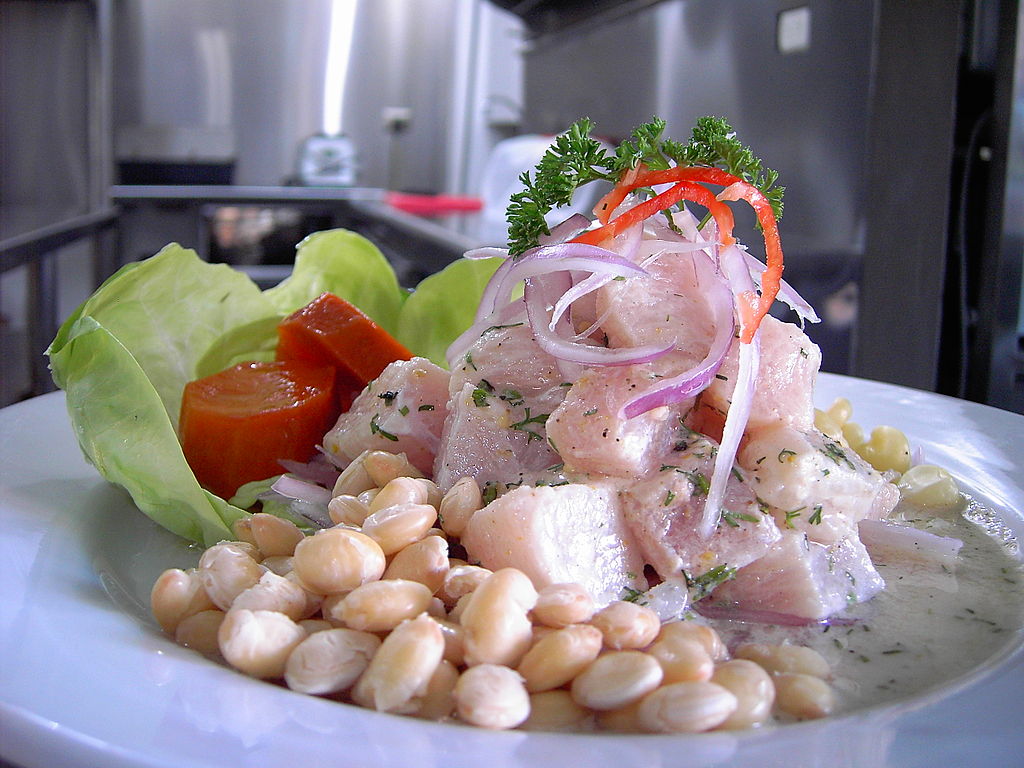 © Wikimedia.org/Picanteria karol, CC BY-SA
© Wikimedia.org/Picanteria karol, CC BY-SA
Adobo or adobar (Spanish: marinade, sauce, or seasoning) is the immersion of cooked food in a stock (or sauce) composed variously of paprika, oregano, salt, garlic, and vinegar to preserve and enhance its flavor. The Portuguese variant is known as Carne de vinha d'alhos. The practice, native to Iberia (Spanish cuisine and Portuguese cuisine), was widely adopted in Latin America, as well as Spanish and Portuguese colonies in Africa and Asia. In the Philippines, the name adobo was given by colonial-era Spaniards on the islands to a different indigenous cooking method that also uses vinegar. Although similar, this developed independently of Spanish influence. (Source: Wikipedia.org, CC BY-SA)
Halo-halo, also spelled haluhalo, Tagalog for 'mixed' (the more common spelling instead literally equating to 'mix-mix'), is a popular cold dessert in the Philippines made up of crushed ice, evaporated milk or coconut milk, and various ingredients including ube jam (ube halaya), sweetened kidney beans or garbanzo beans, coconut strips, sago, gulaman (agar), pinipig, boiled taro or soft yams in cubes, flan, slices or portions of fruit preserves and other root crop preserves. The dessert is topped with a scoop of ube ice cream. It is usually prepared in a tall clear glass and served with a long spoon. Halo-halo is considered to be the unofficial national dessert of the Philippines. (Source: Wikipedia.org, CC BY-SA)
Pancit (Tagalog pronunciation: [panˈsɪt] pan-SIT), also spelled pansít, is a general term referring to various traditional noodle dishes in Filipino cuisine. There are numerous types of pancit, often named based on the noodles used, method of cooking, place of origin, equal and constant diameter or the ingredients. Most pancit dishes are characteristically served with calamansi, as its freshly-squeezed juice may be used for additional seasoning. Noodles were introduced to the Philippines by Chinese immigrants over the centuries. They have been fully adopted and nativized into the local cuisine, even incorporating Spanish influences. There are numerous regional types of pancit throughout the Philippines, usually differing on the available indigenous ingredients of an area. Unique variants do not use noodles at all, but instead substitute it with strips of coconut, young papaya, mung bean sprouts, bamboo shoots, or seaweed. (Source: Wikipedia.org, CC BY-SA)
Sinigang is a Filipino soup or stew characterized by its sour and savory taste. It is most often associated with tamarind (Filipino: sampalok), although it can use other sour fruits and leaves as the souring agent. It is one of the more popular dishes in Filipino cuisine. The soup is usually accompanied by rice. In 2021, sinigang was rated as the world's best vegetable soup by TasteAtlas. Sinigang is most often associated with tamarind in modern times, but it originally referred to any meat or seafood cooked in a sour and acidic broth, similar to but differentiated from paksiw (which uses vinegar). Other variations of the dish derive their sourness from native ingredients. These souring agents include unripe mangoes, butterfly tree leaves (alibangbang), citruses (including the native calamansi and biasong), santol, bilimbi (kamias or iba), gooseberry tree fruits (karmay), binukaw fruits (also batuan), and libas fruits, among others. Guava, introduced to the Philippines via the Manila galleons, is also used. Seasoning powder or bouillon cubes with a tamarind base are commercial alternatives to using natural fruits. (Source: Wikipedia.org, CC BY-SA)
 © Wikimedia.org/Copperhead02, CC BY-SA
© Wikimedia.org/Copperhead02, CC BY-SA
Sisig (/ˈsiːsɪɡ/ Tagalog pronunciation: ['sisig]) is a Filipino dish made from pork jowl and ears (maskara), pork belly, and chicken liver which is usually seasoned with calamansi, onions, and chili peppers. It originates from the Pampanga region in Luzon. According to Cunanan's recipe, preparing sisig comes in three phases: boiling, broiling and finally grilling. A pig's head is first boiled to remove hairs and to tenderize it. Portions of it are then chopped and grilled or broiled. Finally, coarsely chopped onions are added and served on a sizzling plate. (Source: Wikipedia.org, CC BY-SA)
 © Wikimedia.org/Joy L. Cruz, CC BY-SA
© Wikimedia.org/Joy L. Cruz, CC BY-SA
Bigos (Polish pronunciation: [ˈbʲiɡɔs]; Belarusian: бігас, bihas, or бігус, bihus, Lithuanian: bigusas), often translated into English as hunter's stew, is a Polish dish of chopped meat of various kinds stewed with sauerkraut and shredded fresh cabbage. It is served hot and can be enriched with vegetables, spices or wine. Originally from Poland, the dish also became traditional in the areas of the vast Polish–Lithuanian Commonwealth. (Source: Wikipedia.org, CC BY-SA)
Kotlet schabowy (Polish pronunciation: [ˈkɔtlɛt sxaˈbɔvɨ]) is a Polish variety of a breaded cutlet of pork coated with breadcrumbs. It is similar to Viennese schnitzel or Italian cotoletta, and North and South American milanesa. Pork tenderloin is cut into one-inch slices and pounded with a mallet until it becomes thinner and soft. It is marinated in milk and onions. The meat is dipped in flour, then in egg, and then covered in breadcrumbs. Oil or lard is heated in a frying pan till it starts to sizzle and the meat is placed onto it, then turned over a couple of times. Kotlet schabowy can be served with cooked potatoes, mashed potatoes, fried mushrooms, cooked vegetables (seared cabbage), salads or coleslaw. (Source: Wikipedia.org, CC BY-SA)
Pierogi are filled dumplings made by wrapping unleavened dough around a savory or sweet filling and cooking in boiling water. Pierogi or their varieties are associated with the cuisines of Central, Eastern and Southeastern Europe. Dumplings most likely originated in Asia and came to Europe via trade in the Middle Ages. The widely-used English name pierogi was derived from Polish. In some parts of Eastern Europe they are known as varenyky. Pierogi are also popular in modern-day American and Canadian cuisine, where they are sometimes known under different local names. Typical fillings include potato, cheese, quark, sauerkraut, ground meat, edible mushrooms, and/or fruits. Savory pierogi are often served with a topping of sour cream, fried onions, or both. (Source: Wikipedia.org, CC BY-SA)
Caldo verde (pronounced [ˈkaldu ˈveɾðɨ], Portuguese for 'green broth') is a popular soup in Portuguese cuisine. The basic traditional ingredients for caldo verde are finely shredded Portuguese cabbage or couve-galega (essentially a type of collard green), (or alternatively other leafy greens such as kale or mustard greens), potatoes, olive oil, black pepper and salt, mainly flavoured with onion and garlic (some regional recipes favour slight variations, like turnip greens or added meat, such as ham hock, making it similar to Italo-American wedding soup). Traditionally the soup is accompanied by slices of paio, chouriço or linguiça (boiled whole with the potatoes, then sliced and added to the finished soup when serving) and with Portuguese broa corn-bread or rye-bread for dipping. In Portugal, the popular soup caldo verde is typically consumed during Portuguese celebrations, such as weddings, birthdays and popular celebrations. It is sometimes consumed before a main course meal or as a late supper. This soup is served in a tigela, a traditional earthenware bowl. (Source: Wikipedia.org, CC BY-SA)
Pastel de nata (Portuguese pronunciation: [pɐʃˈtɛl dɨ ˈnatɐ] (plural: pastéis de nata; [pɐʃˈtɐjʒ dɨ-])) or Pastel de Belém is a Portuguese egg custard tart pastry, optionally dusted with cinnamon. Outside Portugal, they are particularly popular in other parts of Western Europe, Asia and former Portuguese colonies, such as Brazil, Mozambique, Macau, Goa and East Timor. The Macanese pastel de nata has been adopted by KFC and is available in regions such as Hong Kong, Taiwan and China. In Indonesia, this pastry is especially popular in Kampung Tugu, Jakarta, a culturally Portuguese (Mardijker) enclave. (Source: Wikipedia.org, CC BY-SA)
 © Wikimedia.org/helmut.weigel, CC BY-SA
© Wikimedia.org/helmut.weigel, CC BY-SA
Moambe chicken (French: poulet à la moambe or simply poulet moambe, Portuguese: moamba de galinha) is a savory chicken dish popular in Central Africa and considered the national dish of Angola. The dish itself is made by combining chicken, spices and palm butter to create a stew-like consistency. A number of local or regional variations exist across the Congo and Central Africa; the dish is also known outside the continent. Poulet moambe (French for 'chicken in palm butter sauce') is prepared by cooking chicken in moambe (palm butter) and spinach, then seasoned with spices like peri-peri or red pepper. It is typically served with sweet potatoes, brown onions, hard-boiled eggs and a sauce made from crushed palm nuts. Moambe chicken can also be accompanied by rice or manioc (cassava) paste. The chicken can be substituted with duck or fish. (Source: Wikipedia.org, CC BY-SA)
Mititei (Romanian pronunciation: [mitiˈtej]) or mici (Romanian pronunciation: [mit͡ʃʲ]; both Romanian words meaning 'little ones', 'small ones') is a dish from the Romanian cuisine, consisting of grilled ground meat rolls in cylindrical shape made from a mixture of beef, lamb with spices, such as garlic, black pepper, thyme, coriander, anise, savory, and sometimes a touch of paprika. Sodium bicarbonate and broth or water are also added to the mixture. It is similar to ćevapi and other ground meat based dishes throughout the Balkans and Middle East. It is often served with french fries, mustard and murături (pickled vegetables). (Source: Wikipedia.org, CC BY-SA)
Mămăligă (Romanian pronunciation: [məməˈliɡə] ;) is a porridge made out of yellow maize flour, traditional in Romania, Moldova, Western Ukraine and among Poles in Ukraine, the Black Sea regions of Georgia and Turkey, and Thessaly and Fthiotis, in Greece. Traditionally, mămăligă is cooked by boiling water, salt and cornmeal in a special-shaped cast iron pot called ceaun or tuci. When cooked peasant-style and used as a bread substitute, mămăligă is supposed to be much thicker than the regular Italian polenta to the point that it can be cut in slices, like bread. When cooked for other purposes, mămăligă can be much softer, sometimes almost to the consistency of porridge. Because mămăligă sticks to metal surfaces, a piece of sewing thread is used to cut it into slices instead of a knife; it can then be eaten by holding it with the hand, just like bread. (Source: Wikipedia.org, CC BY-SA)
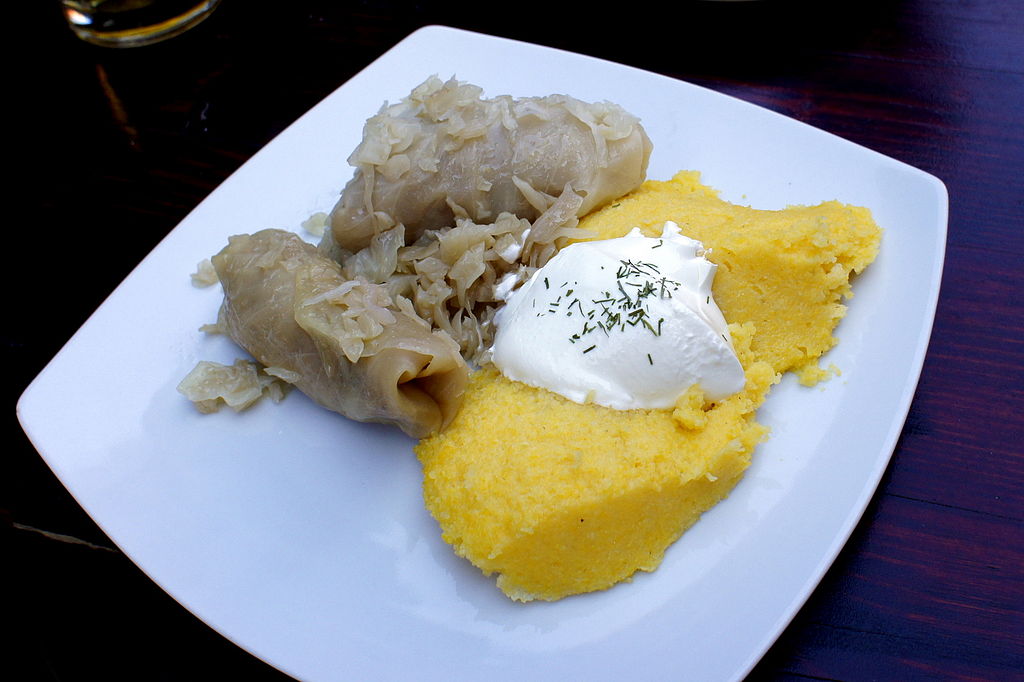 © Wikimedia.org/Stiopa, CC BY-SA
© Wikimedia.org/Stiopa, CC BY-SA
Sarma (Turkish for wrapped; Cyrillic spelling: Сарма), commonly marketed in the English-speaking world as stuffed grape leaves, stuffed vine leaves, or stuffed cabbage leaves, is a food in Southeastern European and Ottoman cuisine made of vegetable leaves rolled around a filling of grains (such as rice), minced meat, or both. The vegetable leaves may be cabbage, patience dock, collard, grapevine, kale or chard leaves. Sarma is part of the broader category of stuffed dishes known as dolma. In Romania and Moldova, sarmale are popular in all historical regions, including Moldavia, Transylvania, and Wallachia. This original Turkish dish slowly became integrated into Romania's culture after the Ottoman Empire conquered the Roman Empire which Romania was a part of. (Source: Wikipedia.org, CC BY-SA)
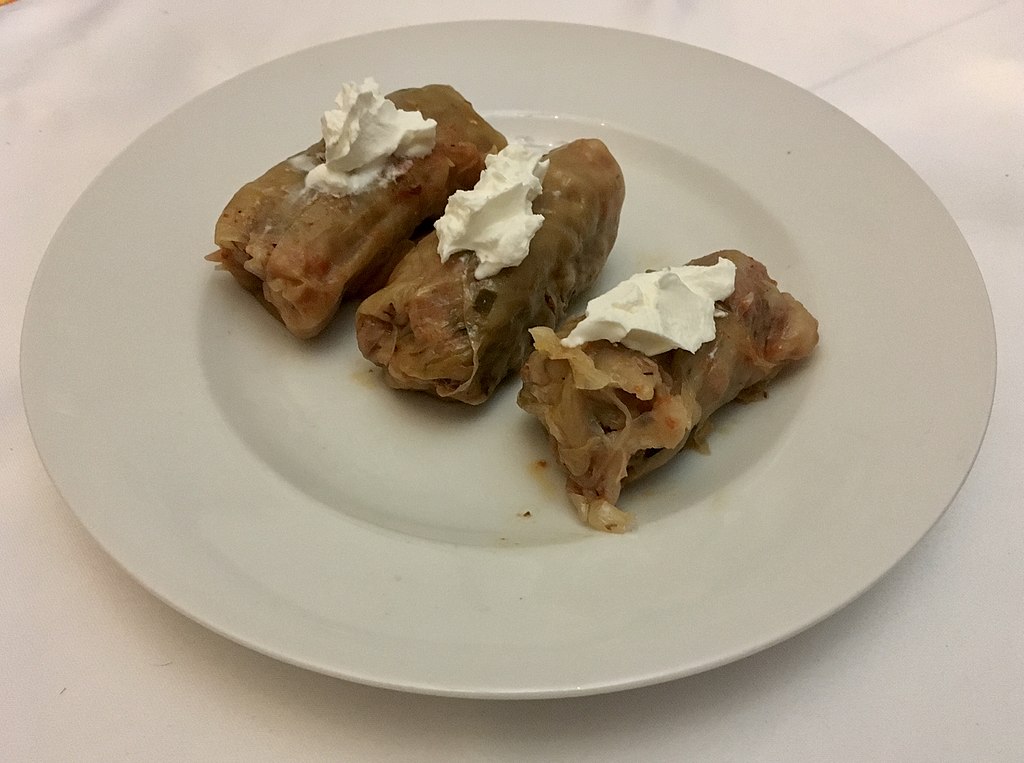 © Wikimedia.org/Andrei, CC0
© Wikimedia.org/Andrei, CC0
Bublik (also booblik or bublyk; Russian: бублик, tr. búblik, plural: bubliki; Ukrainian: бублик, romanized: búblyk) is a traditional Eastern European bread roll. It is a ring of yeast-leavened wheat dough, that has been boiled in water for a short time before baking. In Russian and Ukrainian, bublik is often used as a generic designation for any ring-shaped product of this type. In Russian, baranka is also used as a similar generic term, whereas 'baranka-type products [ru]' (Russian: бараночные изделия, tr. baranochnye izdeliya) is a formal designation of the product class. A cognate term, obarinok (обарінок) or obvarinok (обварінок), is sometimes used as a synonym for bublik or baranka in Ukrainian. Bublik or baranka is known as abaranak (абаранак) in Belarusian and riestainis or baronkos in Lithuanian. (Source: Wikipedia.org, CC BY-SA)
A blini (plural blinis or blini, rarely bliny; Russian: блины pl.), traditionally also called a blin (a form not even mentioned in some English dictionaries), is a Russian and more broadly Eastern European pancake traditionally made from buckwheat flour or nowadays wheat and served with smetana, tvorog, butter, caviar and other garnishes. Blini are among the most popular and most-eaten dishes in Russia. In the West, blini traditionally refers to small (2–4 inches in diameter) savory pancakes made with leavened batter. In modern Russian, the term most often refers to pan-sized leavened thin pancakes, although smaller leavened pancakes are also called blini and were much more common historically.[citation needed] (Source: Wikipedia.org, CC BY-SA)
In English, kasha usually refers to the pseudocereal buckwheat, informally grechka, or its culinary preparations. In various East-Central and Eastern European countries, kasha can apply to any kind of cooked grain. It can be baked but most often is boiled, either in water or milk, and therefore the term coincides with the English definition of 'porridge', but the word can also refer to the grain before preparation, which corresponds to the definition of 'groats'. This understanding of kasha concerns mainly Belarus (каша), the Czech Republic (kaše), Lithuania (košė), Poland (kasza), Romania and the Republic of Moldova (cașa), Russia (каша), Slovakia (kaša), Slovenia (kaša), Kazakhstan, and Ukraine (каша), where the term, besides buckwheat, can apply to wheat, barley, oats, millet and rye. Kashas have been an important element of Slavic diet for at least 1,000 years. (Source: Wikipedia.org, CC BY-SA)
Oladyi (Russian: оладьи pl., diminutive: оладушки, oladushki, sg. оладья, oladya, Ukrainian: оладки, oladky) are small thick pancakes or fritters common in Russian cuisines, Ukrainian cuisines. The batter for oladyi is made from wheat or (nowadays more rarely) buckwheat flour, eggs, milk, salt and sugar with yeast or baking soda. The batter may also be based on kefir, soured milk or yoghurt. It may contain various additions, such as apple or raisins. Oladki are usually served with smetana (sour cream), as well as with sweet toppings such as jam, powidl, honey etc. Savoury versions may be served with caviar, similarly to blini. (Source: Wikipedia.org, CC BY-SA)
Pelmeni (Russian: пельмени—plural, pronounced [pʲɪlʲˈmʲenʲɪ]; pelmen, Russian: пельмень—singular, pronounced [pʲɪlʲˈmʲenʲ]) are dumplings of Russian cuisine that consist of a filling wrapped in thin, unleavened dough. It is debated whether they originated in Ural or Siberia. Pelmeni have been described as 'the heart of Russian cuisine'. The dough is made from flour and water, sometimes adding a small portion of eggs. The filling can be minced meat (pork, lamb, beef, fish or any other kind of meat, venison being particularly traditional for colder regions) or mushrooms, or a combination of the two. The mixing together of different kinds of meat is also popular. The traditional Udmurt recipe requires a mixture of 45% beef, 35% mutton, and 20% pork. Various spices, such as black pepper and diced onions as well as garlic, are mixed into the filling. They are commonly topped with sour cream, mayonnaise, dill, red onions or vinegar, all of which are traditional to the region and can be produced in the Siberian climate. (Source: Wikipedia.org, CC BY-SA)
Pirozhki (Russian: пирожки́, tr. pirožkí, IPA: [pʲɪrɐʂˈkʲi]) are foremost, Russian baked or fried yeast-leavened boat-shaped buns with a variety of fillings. Pirozhki are a popular street food and comfort food in Eastern Europe. A typical pirozhok is boat- or rarely crescent-shaped, made of yeast-leavened dough, with filling completely enclosed. Similar Russian pastries (pirogs) of other shapes include coulibiac, kalitka, rasstegai, and vatrushka. Pirozhki are either fried or baked. They come in sweet or savory varieties. Common savory fillings include ground meat, mashed potato, mushrooms, boiled egg with scallions, or cabbage. Typical sweet fillings are fruit (apple, cherry, apricot, lemon), jam, or tvorog. (Source: Wikipedia.org, CC BY-SA)

Time for recess! Post a comment, ask a question or write a review. Feel free to let us know what you think!
look at the sign on the road to avoid accidents and horrible driving conditions
I received a 300$ ticket because I passed a police control of other cars/drivers on the right lane of a highway (the control was on the hard shoulder of the highway). Is it really true, that you have to change the lane in such cases? Thanks!
I am an American living in Italy. The Italian Drivers License theory test is the hardest test I have ever studied for and I am in my 70s have multiple degrees, multiple professional certifications. Have to take the Italian Drivers Theory test in Italian. No english. So many rules. More signs in small medieval Italian town I live in then in major US cities I have lived in. No Italian license no driving. No buying or renting a car. Test here was good, clean. Lots of tricky questions on many practice and real official tests. Thanks
Most problems are a result of higher than safe driving speeds. Please just slow down and be patient.
Question 121: Poor translation: Vehicles with polluted fluids prohibited Should be translated as: Vehicles with dangerous liquids prohibited
Question 83: Poor translation: Vehicles with polluted fluids prohibited Should be translated as: Vehicles with dangerous liquids prohibited
Want even more practice? Visit similar websites offering realistic practice driving knowledge tests. Visit us to see what sets our tests apart! https://dkttest.com/capital-territory/
Cool tool! And fun to check whether I remember the rules :) Two things I noticed: Warning for a crossroad side roads on the left and right. While technically that might be the correct translation, this sign tells you, that you are on the main road and have the right of way for the next crossroad and only the next crossroad. Usually (if no sign specifies otherwise) you have to give way to drivers coming from the right at every intersection, which can get a bit annoying in communal areas, so seeing this sign feels less like a warning and more like relief :). A Fahrradstraße is not a lane for cyclists but a street for cyclists, meaning the (whole!) street is intended predominantly for cyclists, who are then allowed to ride next to each other. Cars are allowed to drive there (unless another sign prohibits such), but have to adjust their speed to the cyclists. I believe they are not allowed to pass at all, even if the oncoming lane is empty.
More community